Risk Contextualization for Nuclear Systems †
Abstract
:1. Introduction
2. Symptom-Based Context and Uncertainty Vector
3. HRA Context for NPP Safety
3.1. HRA Development
3.2. Approaches to the Facility–Activity System Description, Modeling and Management
- Person approach and system approach to modeling and managing HFE.
- 2.
- An approach to describing the FAS based on PSFs and an approach to describing the FAS variability of the system based on symptoms/CFCs are illustrated in Figure 4.
- extended application of the symptom-based approach to NPP accident management.
- The symptom-based approach is common in nuclear accident management. The IAEA NS-R-2 [17] establishes the following requirements for accident management: “The training of operating personnel shall ensure their familiarity with the symptoms of accidents beyond the design basis and with the procedures for accident management”. Later in IAEA SRS No. 48 [18], “symptom/state-based procedures” were justified. In IAEA NS-G-2.15 [19], a ‘symptom-based approach’ was also recommended: ‘2.14. The approach in accident management should be based on directly measurable plant parameters or parameters derived from these by simple calculations’.
- possibility for statistical entropy description of macroscopic FAS in addition to the microscopic causal description.
- ability to solve theoretical questions about explored/unexplored mental processes;
- applicability for extending the definitions of images, errors, violations, holistics, and dynamics of context;
- the PET procedure for evaluation of context, cognition, communication, and decision-making error probabilities consists of eight steps, and its iterative and recursive character in the spiral evaluation steps are also presented in [7].
3.3. Description of the Scenario Context Qualification and Quantification Process
4. Multi-Unit PSA Contextualization and Risk Aggregation
4.1. Multi-Unit PSA and Risk Aggregation Metrics
- site CDF (SCDF) and site LERF (SLERF);
- multi-unit CDF (MUCDF) and multi-unit LERF (MULERF).
4.2. Contextual Challenges for Multi-Unit PSA and Risk Aggregation
- How are the dynamic outputs of complex and time-consuming DM codes converted into PM input?
- How is the stochastic input in dynamic PSA or in contextual SUPSA or MUPSA models represented, and with what software tools?
- How are dependencies considered to reduce the transmitted and aggregated uncertainty from the DMs and PMs to the risk-informed outcomes and measures?
4.3. Suboptimal Safety Information Transfer
- (i)
- DSA capacity (CDSA) includes the following:
- TH simulations of groups of postulated IEs (PIEs);
- Detailed dynamic TH models;
- Basis for full-scope simulators with multi-step procedures;
- FAS context can be modeled and defined much better than by expert judgment.
- (ii)
- PSA capacity (CPSA) includes the following:
- Limited set/list of PIEs;
- Detailed static ET-FT models;
- Powerful software tools;
- Expertly judged HEPs for HFEs of the critical operator’s actions or tasks.
4.4. Features of Dynamic MUPSA Options
- i.
- TH behavior of the NPP (reports, TH code, or full-scope simulations);
- ii.
- External event study (such as flooding, tsunami, earthquake, etc.); and
- iii.
- Operator responses to the accident based on operational manuals.
5. Contextual Site PSA
5.1. Risk Metrics for Contextual Site PSA
- i is the number of single units or hazards on the NPP site; I is the total number of units/hazards;
- ji is the number of PIEs for i single units or hazards; ji = 1…Ji, Ji is the total number of PIEs;
- kji is the number of sequences (scenarios) of j PIEs for i single units/hazards; kji = 1…Kji; Kji is the total number of sequences for j PIEi.
5.2. Example for a Contextual Site PSA
5.3. Dynamic Contextextual Risk Monitoring for Risk-Informed Decision Making and Applications
6. Conclusions
Funding
Data Availability Statement
Conflicts of Interest
References
- IAEA. Safety Assessment for Facilities and Activities; IAEA Safety Standards Series No. GSR Part 4 (Rev. 1); IAEA: Vienna, Austria, 2016. [Google Scholar]
- IAEA. Development and Application of Level 1 Probabilistic Safety Assessment for Nuclear Power Plants; IAEA Safety Standards Series No. SSG-3 (Rev. 1); IAEA: Vienna, Austria, 2024. [Google Scholar]
- Petkov, G. Risk Contextualization. In Proceedings of the 16th International Probabilistic Safety Assessment and Management Conference 2022 (PSAM 16), Honolulu, HI, USA, 26 June–1 July 2022. PE241 PSAM16. [Google Scholar]
- NRC. Understanding Risk: Informing Decisions in a Democratic, Society; Stern, P.C., Fineberg, H.V., Eds.; Committee on Risk Characterization: Washington, DC, USA, 1996. [Google Scholar]
- IAEA. Considerations on Performing Integrated Risk Informed Decision Making; IAEA-TECDOC-1909; IAEA: Vienna, Austria, 2020. [Google Scholar]
- Petkov, G. Dynamic Contextual Multi-Unit HRA and PSA; IAEA-EVT1804903; IAEA: Vienna, Austria, 2019. [Google Scholar]
- Petkov, G. Symptom-based context quantification for dynamic accident analysis. Saf. Sci. J. 2018, 121, 666–678. [Google Scholar] [CrossRef]
- Spurgin, A.J. Human Reliability Assessment Theory and Practice; CRC Press: Boca Raton, FL, USA, 2009. [Google Scholar]
- Petkov, G. Dynamic PSA for Holistic Risk-Informed and Context-Based Decision Making. In Proceedings of the OECD/NEA International Workshop on Dynamic PSA and its Role in RIDM, NRC Headquarters, Rockville, MD, USA, 16–17 November 2023. [Google Scholar]
- Barriere, M.T.; Bley, D.C.; Cooper, S.E.; Forester, J.; Kolaczkowski, A.; Luckas, W.J.; Parry, G.W.; Ramey-Smith, A.M.; Thompson, C.; Whitehead, D.; et al. Technical Basis and Implementation Guidelines for A Technique for Human Event Analysis (ATHEANA); NUREG-1624; US NRC: Washington, DC, USA, 1998.
- Petkov, G. Contextual Integrated Risk-Informed Decision-Making; IAEA-EVT2005411; IAEA: Vienna, Austria, 2022. [Google Scholar]
- Knight, F. Risk, Uncertainty, and Profit; Houghton Mifflin Company: Boston, MA, USA, 1921. [Google Scholar]
- Swain, A.D.; Guttmann, H.E. Handbook of Human Reliability Analysis with Emphasis on Nuclear Power Plant Applications; NUREG/CR-1278; US NRC: Washington, DC, USA, 1983. [Google Scholar]
- Dougherty, E. Context and Human Reliability Analysis. Reliab. Eng. Syst. Saf. 1993, 41, 25–47. [Google Scholar] [CrossRef]
- Hollnagel, E. Human Reliability Analysis: Context and Control; Academic Press: London, UK, 1993; 336p. [Google Scholar]
- Reason, J. Human error: Models and management. BMJ 2000, 320, 768–770. [Google Scholar] [CrossRef] [PubMed]
- IAEA. Safety Of NPPs: Operation; IAEA Safety Standards Series No. NS-R-2; IAEA: Vienna, Austria, 2000. [Google Scholar]
- IAEA. Safety Reports Series No. 48. Development and Review of Plant Specific Emergency Operating Procedures; IAEA: Vienna, Austria, 2006. [Google Scholar]
- IAEA. Severe Accident Management Programs for Nuclear Power Plants; IAEA No. NS-G-2.15; IAEA: IAEA: Vienna, Austria, 2009. [Google Scholar]
- Petkov, G.; Todorov, V.; Takov Tl Petrov, V.; Vladimirov, V.; Stoychev, K.; Chukov, I. Safety Investigation of Team Performance in Accidents. J. Hazard. Mater. 2004, 111, 97–104. [Google Scholar] [CrossRef] [PubMed]
- Shannon, C. A mathematical theory of communication. Bell Syst. Tech. J. 1948, 27, 379–423. [Google Scholar] [CrossRef]
- IAEA. Risk Aggregation for Nuclear Installations; IAEA-TECDOC-1983; IAEA: Vienna, Austria, 2021. [Google Scholar]
- Mandelli, D.; Parisi, C.; Alfonsi, A.; Maljovec, D.; Boring, R.; Ewing, S.; Germain, S.; Smith, C.; Rabiti, C.; Rasmussen, M. Multi-unit dynamic PRA. Reliab. Eng. Syst. Saf. 2019, 185, 303–317. [Google Scholar] [CrossRef]
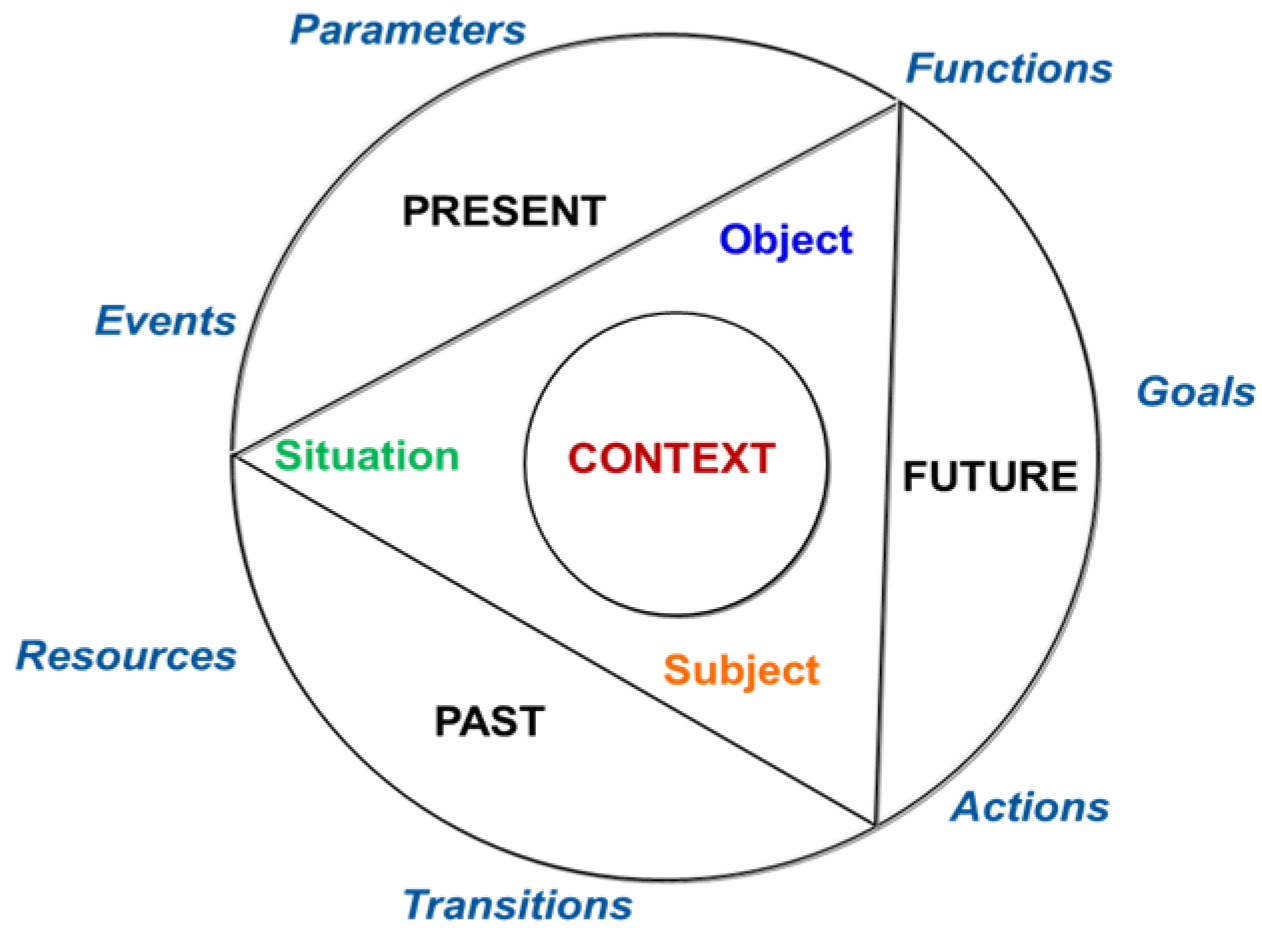
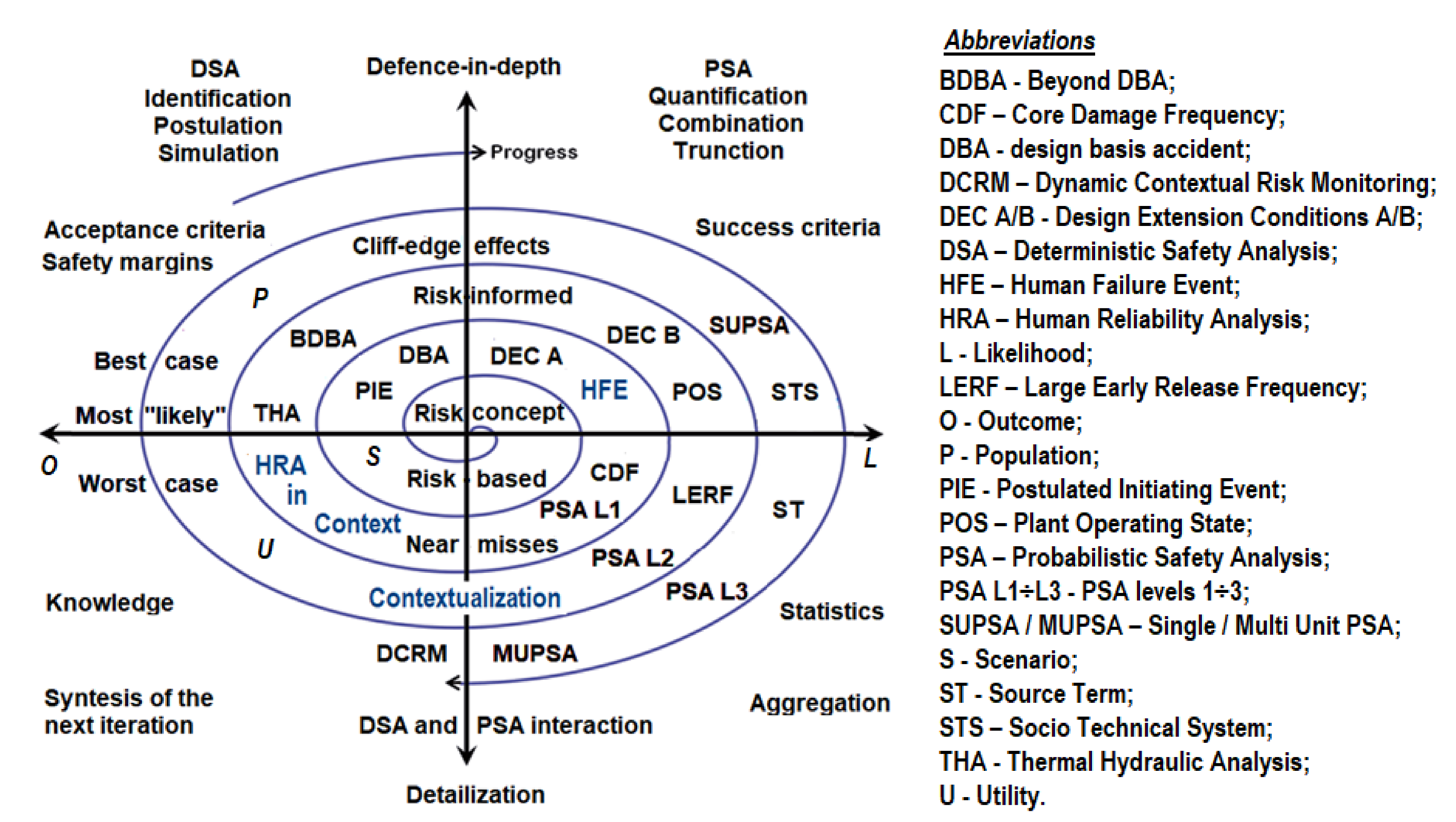
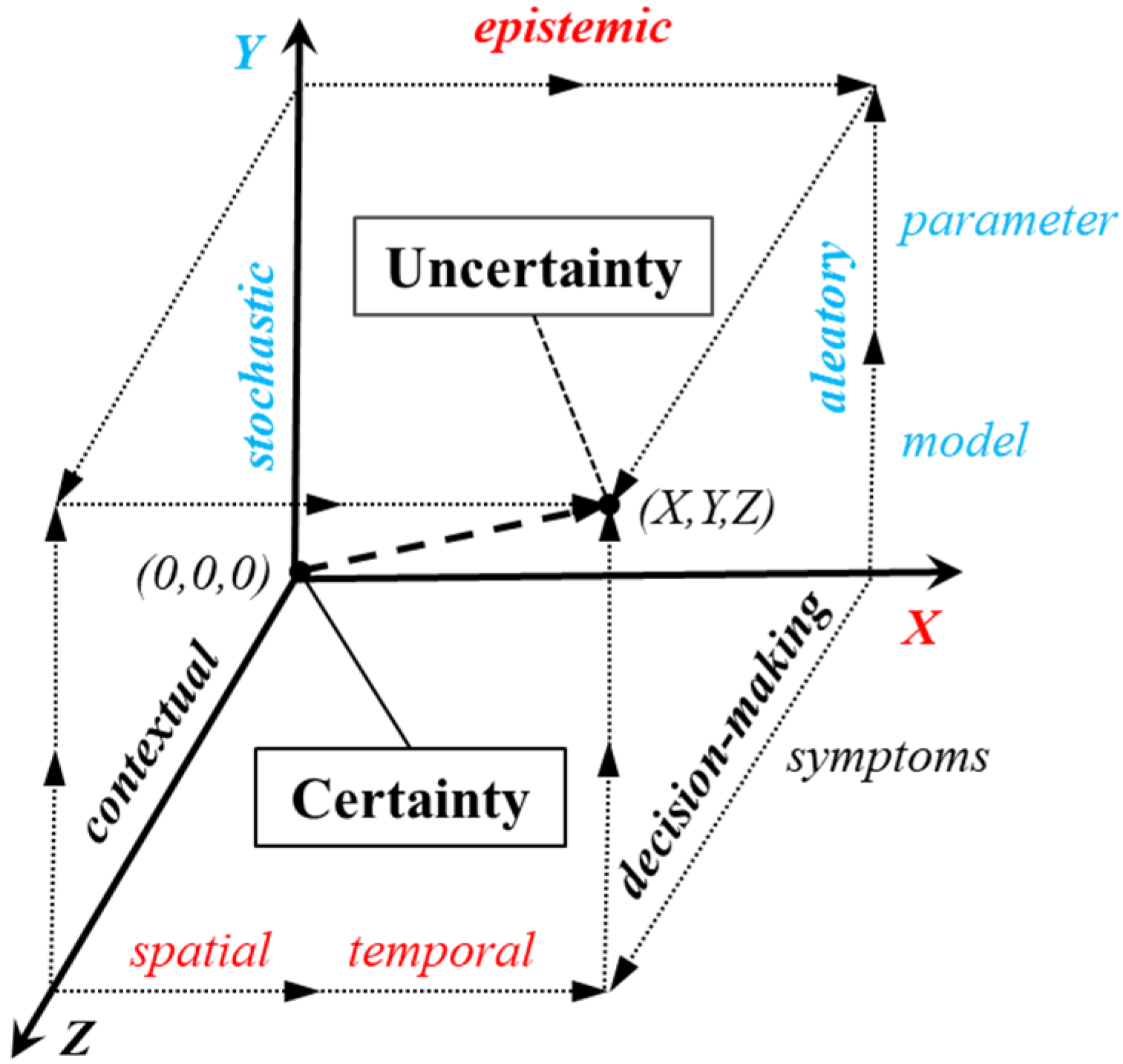
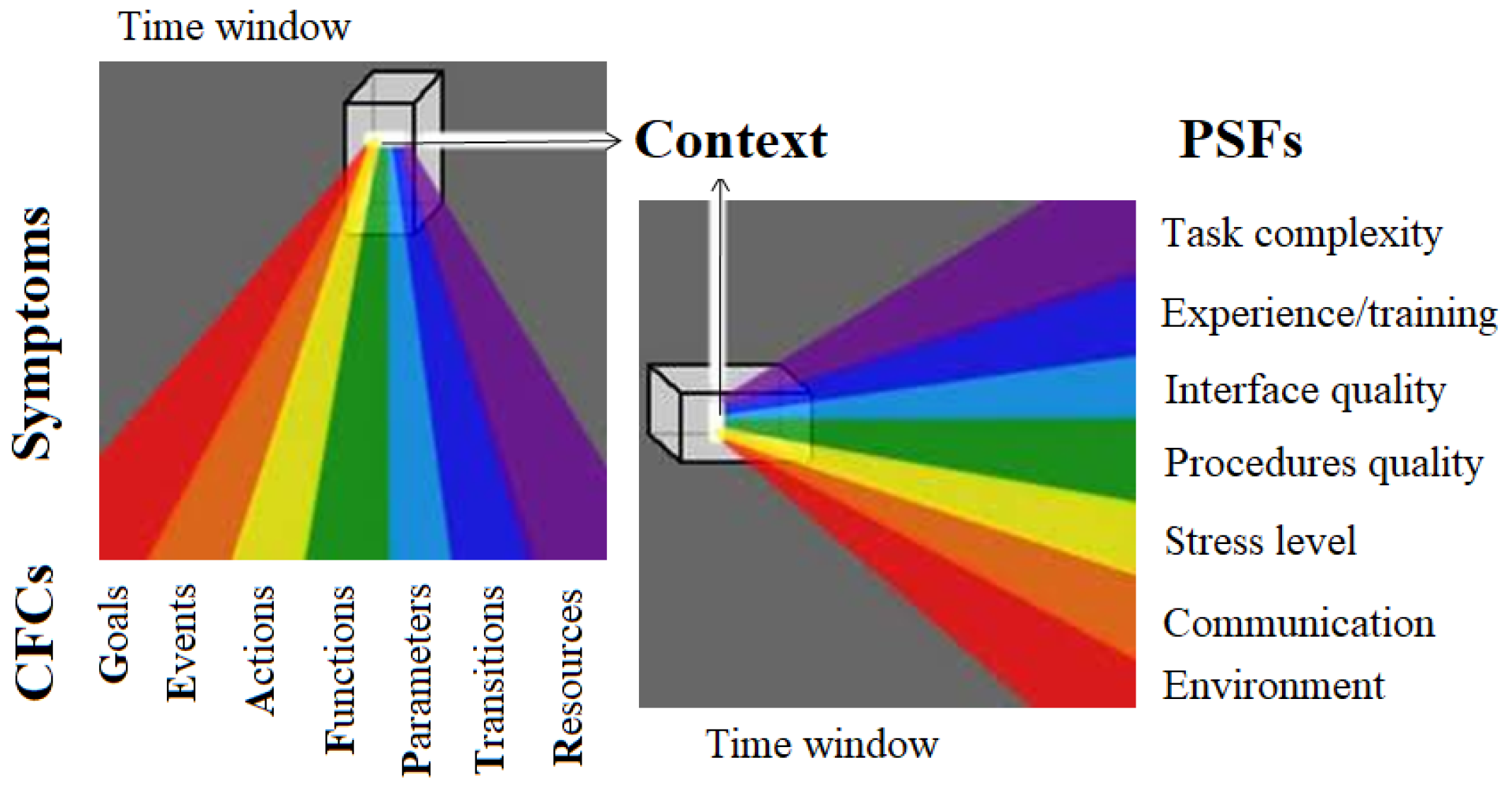
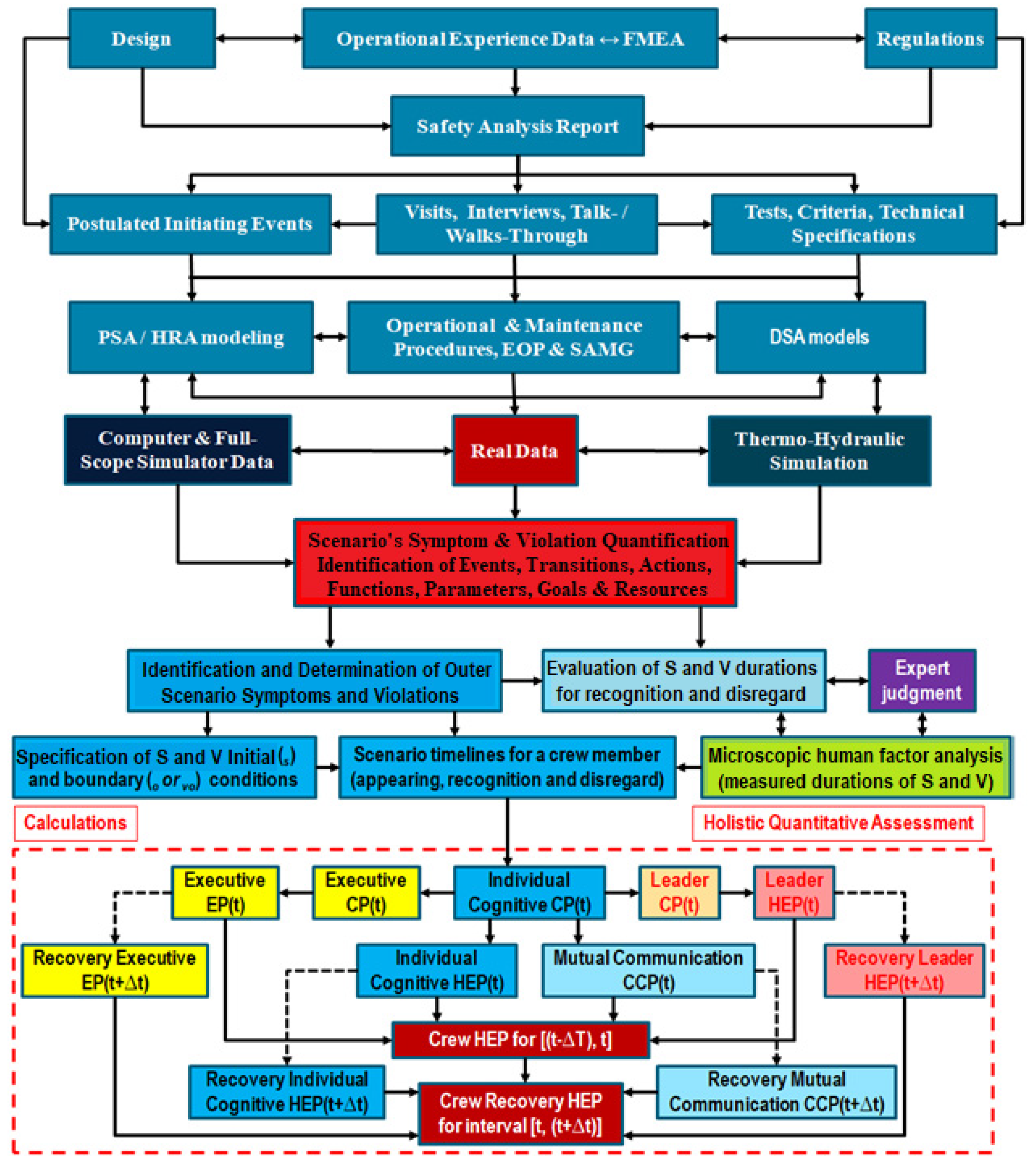
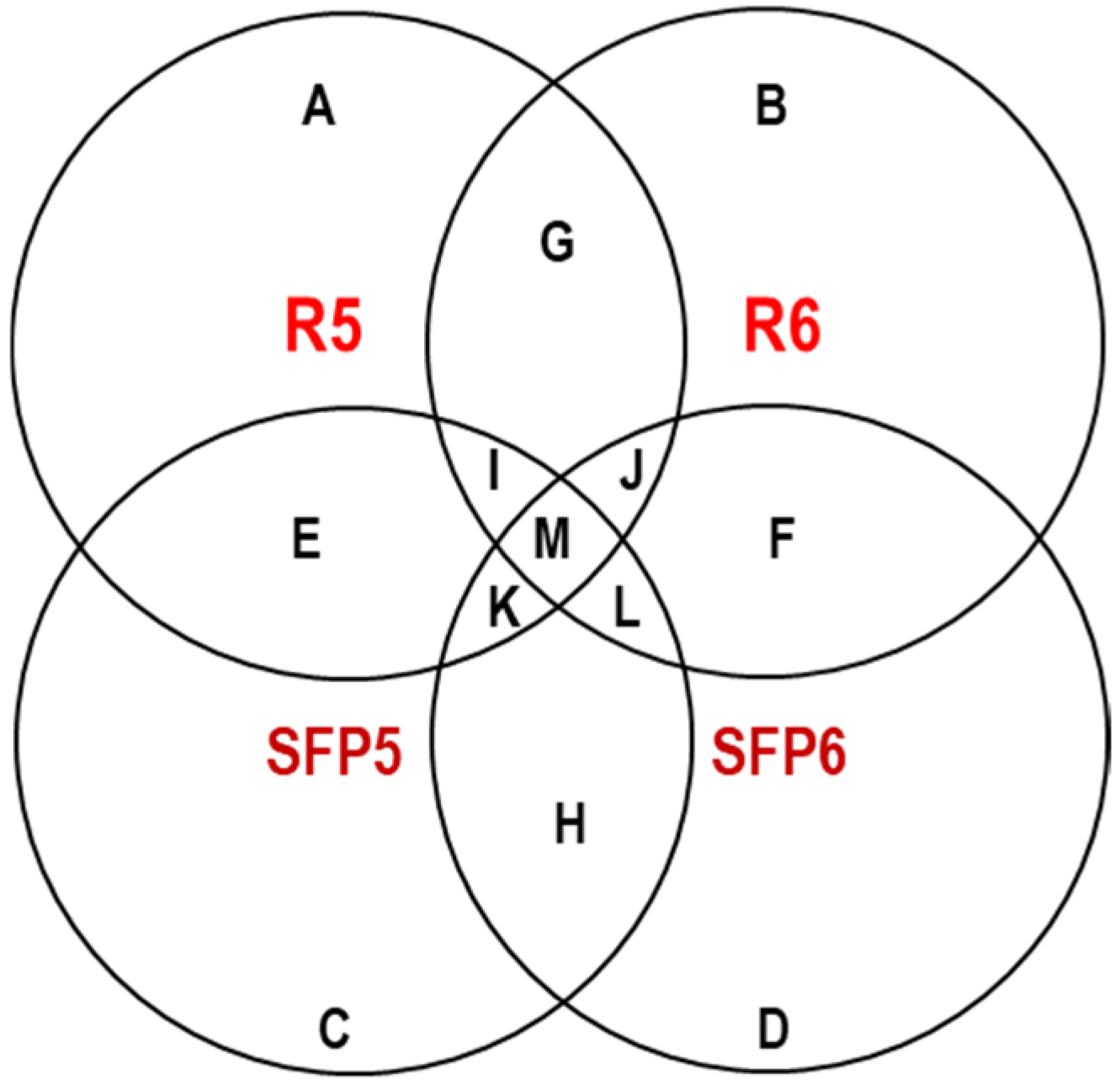

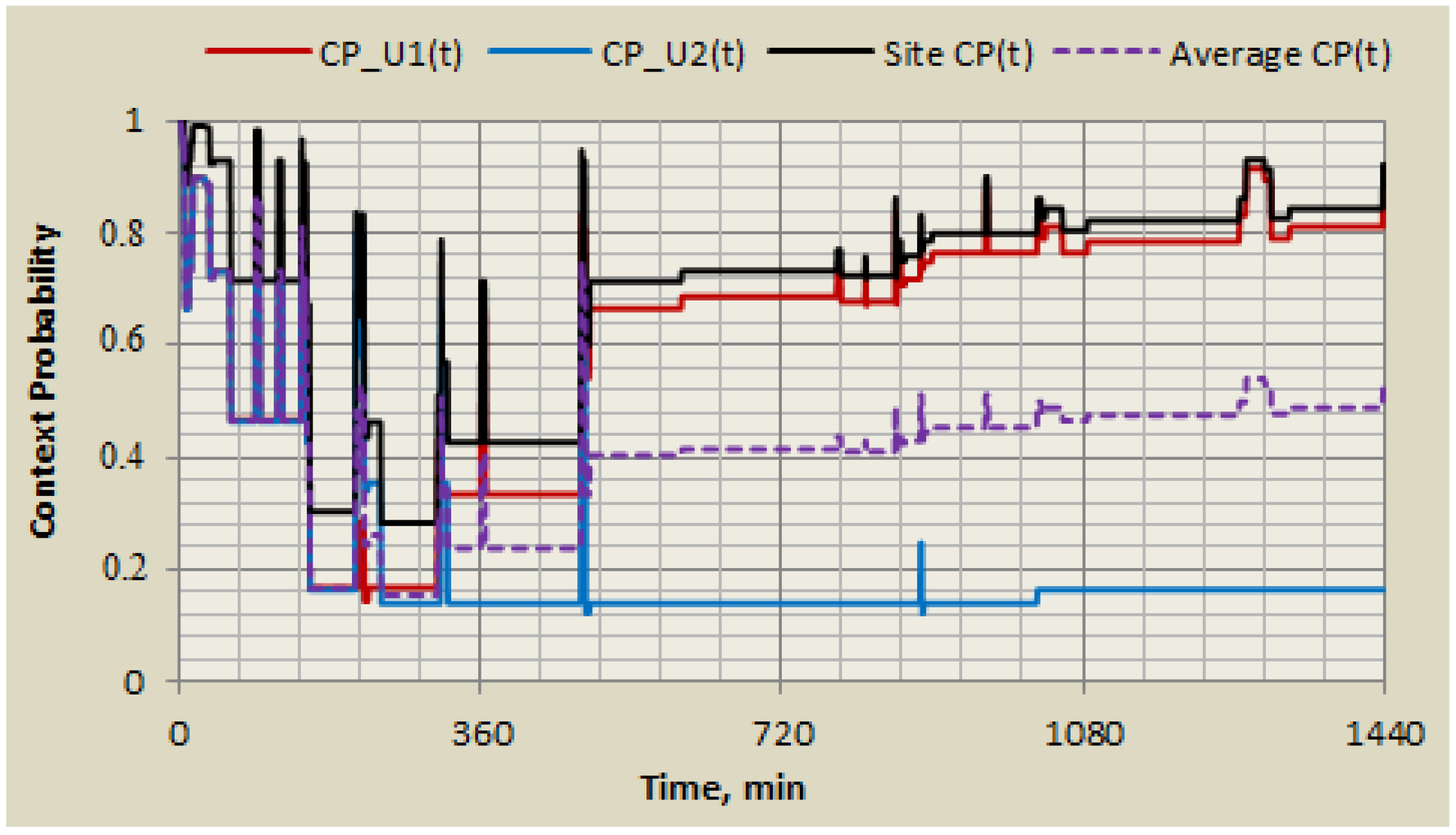
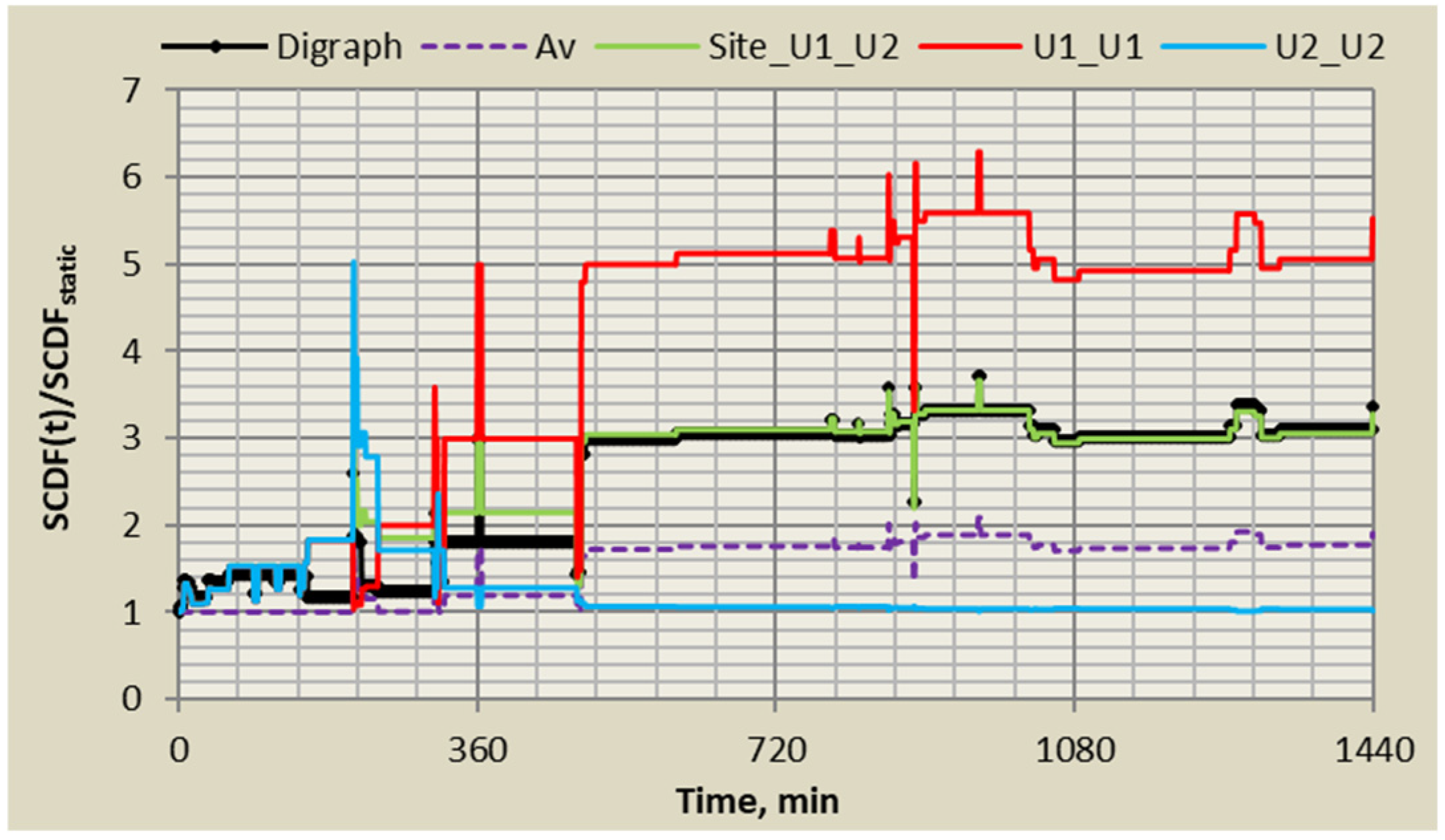
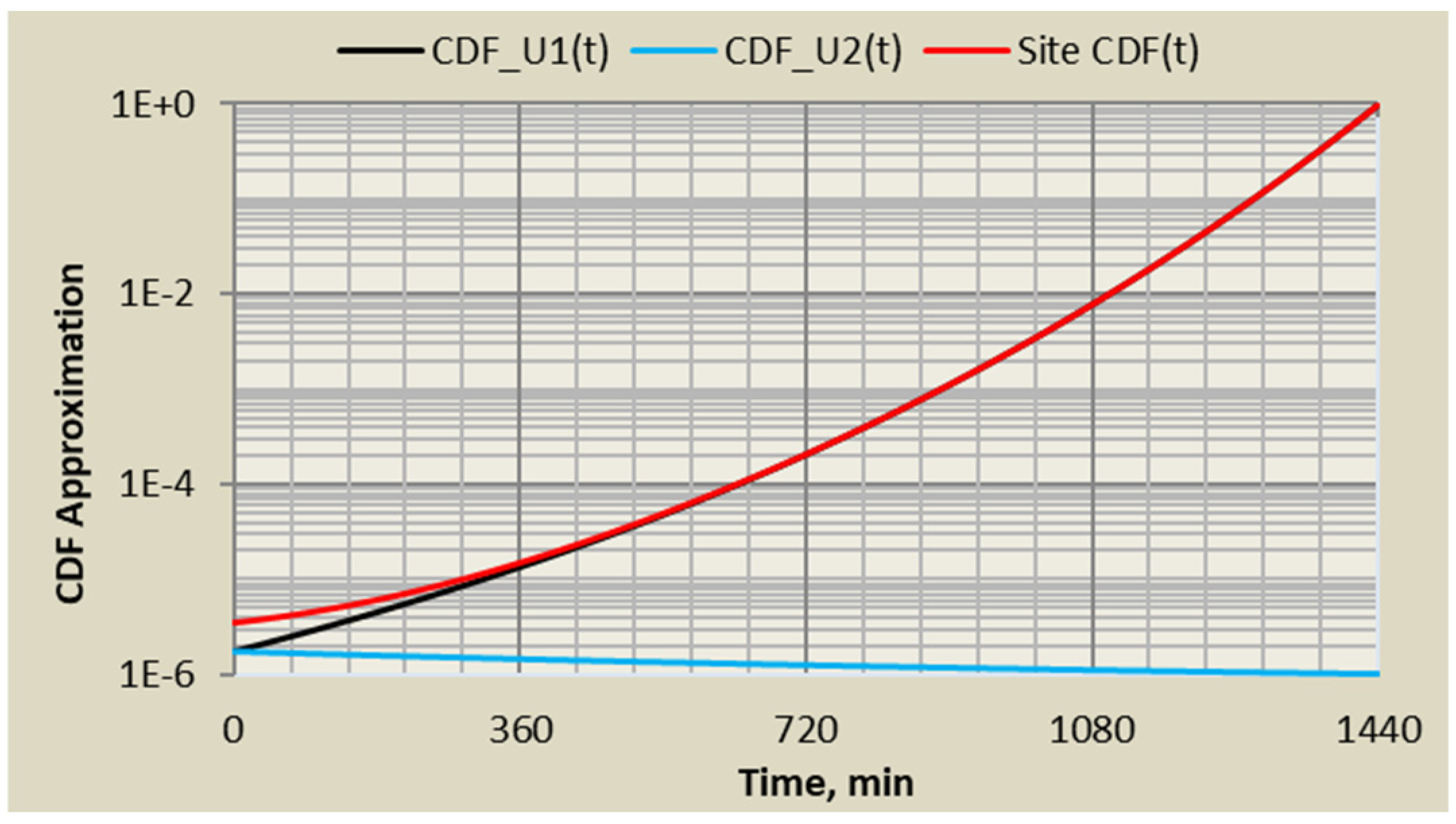
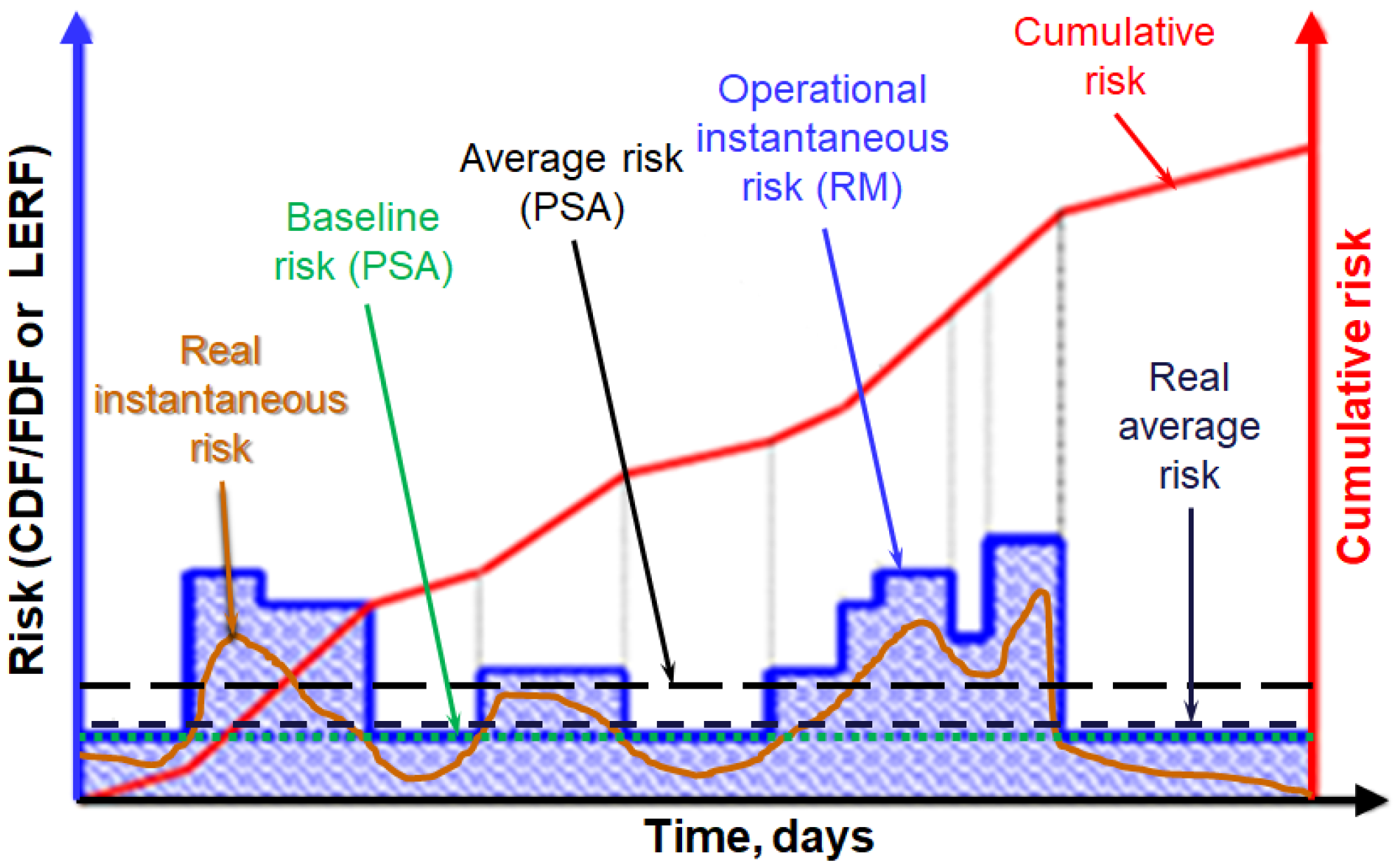
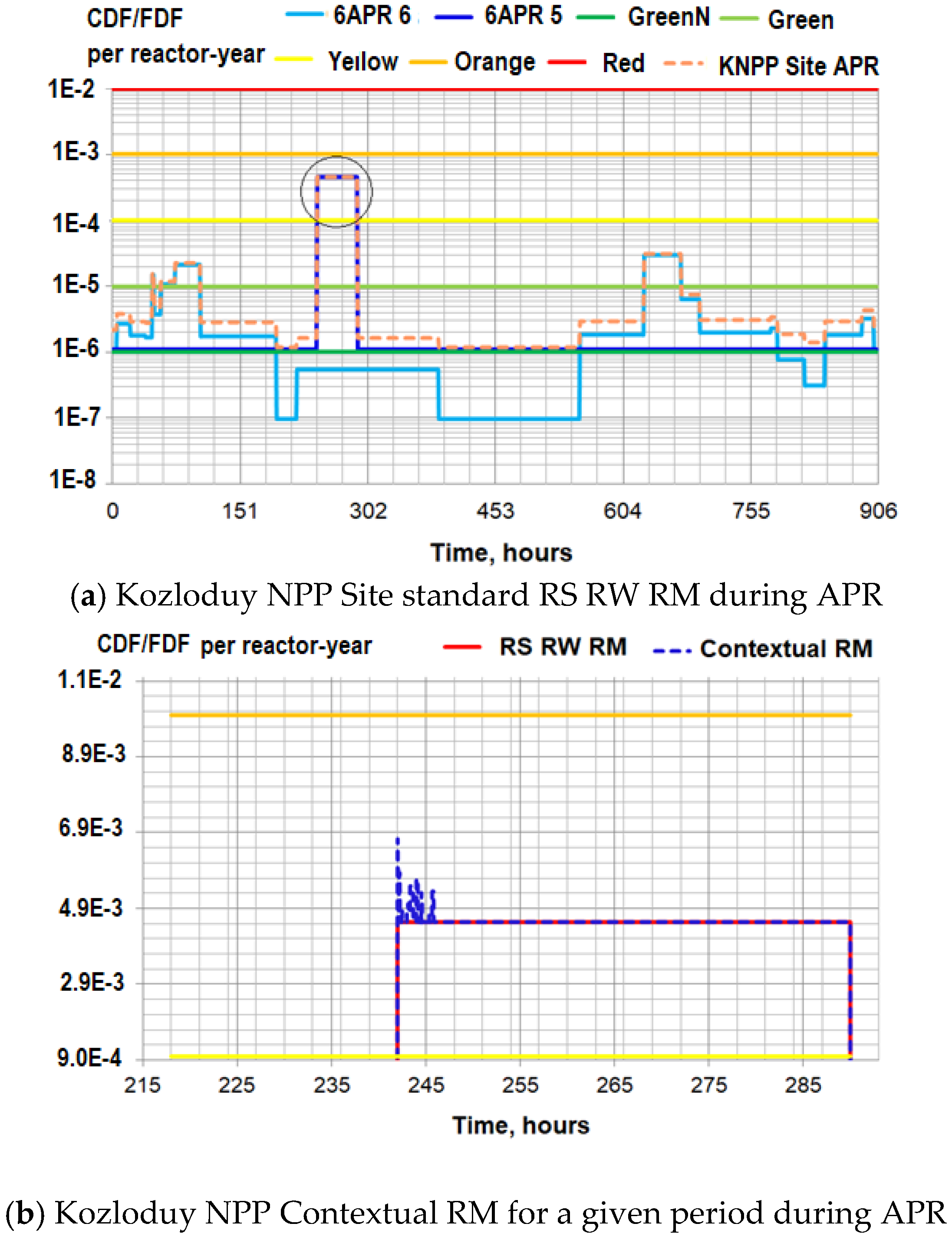
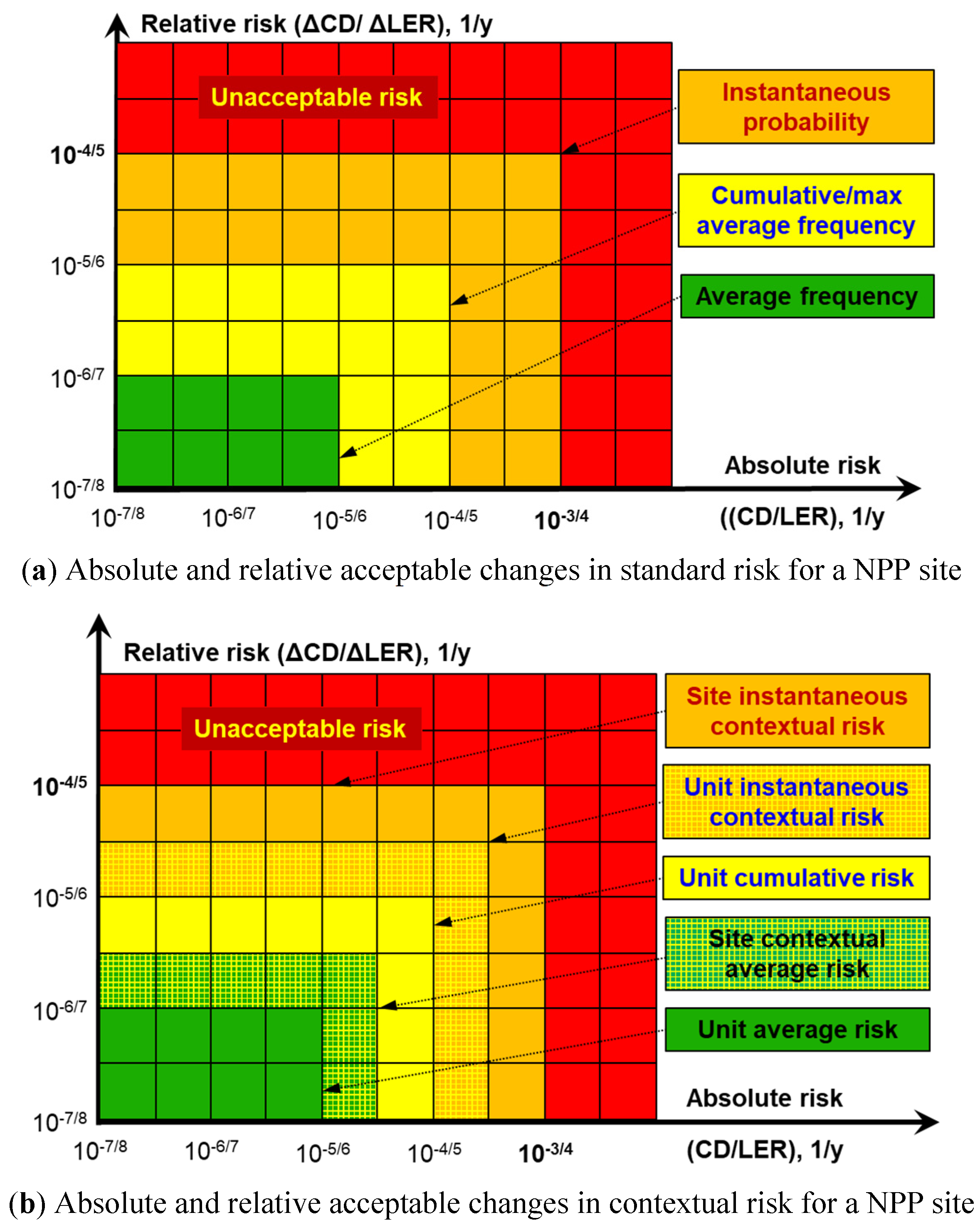
| Completeness | Objectiveness | Inference Cleanliness |
| Determined by the inability to demonstrate that the study covers all possible accident sequences or states and cannot be directly calculated. | Determined by the limitations of the methods used, the presence of various assumptions and simplifications in the models. | Determined by the parametric uncertainty of the reliability indicators and risk metrics. A probability distribution is used to obtain different probabilities for various outcomes to occur. |
| Sources: scope and list of PIE and hazards, failures and HFEs, treatment of phenomena and dependency. | Sources: supporting documents and analyses of success criteria, assumptions, human actions, and model errors. | Sources: input parameters as a number of actual requests, sample size, population definition and data estimation models. |
Disclaimer/Publisher’s Note: The statements, opinions and data contained in all publications are solely those of the individual author(s) and contributor(s) and not of MDPI and/or the editor(s). MDPI and/or the editor(s) disclaim responsibility for any injury to people or property resulting from any ideas, methods, instructions or products referred to in the content. |
© 2024 by the author. Licensee MDPI, Basel, Switzerland. This article is an open access article distributed under the terms and conditions of the Creative Commons Attribution (CC BY) license (https://creativecommons.org/licenses/by/4.0/).
Share and Cite
Petkov, G. Risk Contextualization for Nuclear Systems. J. Nucl. Eng. 2025, 6, 1. https://doi.org/10.3390/jne6010001
Petkov G. Risk Contextualization for Nuclear Systems. Journal of Nuclear Engineering. 2025; 6(1):1. https://doi.org/10.3390/jne6010001
Chicago/Turabian StylePetkov, Gueorgui. 2025. "Risk Contextualization for Nuclear Systems" Journal of Nuclear Engineering 6, no. 1: 1. https://doi.org/10.3390/jne6010001
APA StylePetkov, G. (2025). Risk Contextualization for Nuclear Systems. Journal of Nuclear Engineering, 6(1), 1. https://doi.org/10.3390/jne6010001







